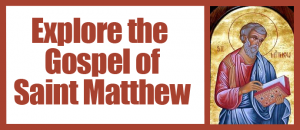We continue to look at the books of the New Testament (NT) in the chronological order in which they were written. The next book we must consider is the Gospel of Matthew.
Matthew was written a decade or two after Mark, in the 80s or perhaps early 90s. Along with John, it is one of two gospels named after a disciple of Jesus. According to chapter 9 verse 9 of this Gospel, Matthew was a tax collector before Jesus called him to be a disciple. Mark and Luke tell the same story, but name the tax collector “Levi”. They could be different names for the same person. The name Matthew also appears in all the lists of the twelve disciples in the gospels and Acts.
For centuries, it has been taken for granted that this gospel was written by this Matthew, and thus by an eyewitness of the historical life of Jesus. And not just any eyewitness, but one of the inner circle of twelve.
Mainstream modern scholarship does not think this to be likely. Recall that names were assigned to the gospels only in the second century. The gospel of Matthew does not claim to be written by Matthew, one of the twelve disciples. Moreover, its date in the last decades of the first century makes it unlikely that it was written by somebody who knew the historical Jesus. Finally, the author used Mark as his major source. Would an eyewitness have done this? Would an eyewitness use a source written by somebody who was not an eyewitness?
Ultimately, however, who the author was does not matter, for all we can know can only be inferred from the way the author puts the story of Jesus together. For all practical purposes we call this Matthew’s Gospel.
In an important sense, Matthew is an expanded version of Mark. Matthew used 90 percent of Mark (about 600 of Mark’s 678 verses) in his 1,071 verses. To Mark he added birth stories (48 verses) and about 400 verses mostly of Jesus’ teaching. About 200 of those come from the manuscript “Q”, the collection of Jesus’ teaching shared with Luke. The rest are mostly sayings and parables not found in the other gospels. These include parts of the Sermon on the Mount and parables like the weeds, the hidden treasure, the pearl of great value, and the unmerciful servant and the workers in the vineyard.
Matthew’s gospel in its present form was written in a Jewish milieu, probably after the destruction of Jerusalem in 70 CE. There is also the anti-Pharisee and anti-scribe polemic in Matthew which indicates a fairly complete rift between Christians and official Judaism. By the year 85 CE Christians were unwelcome in Jewish synagogues. Matthew calls them “their synagogues” to distinguish Jewish from Christian worship. If you can, start reading Matthew’s Gospel.

